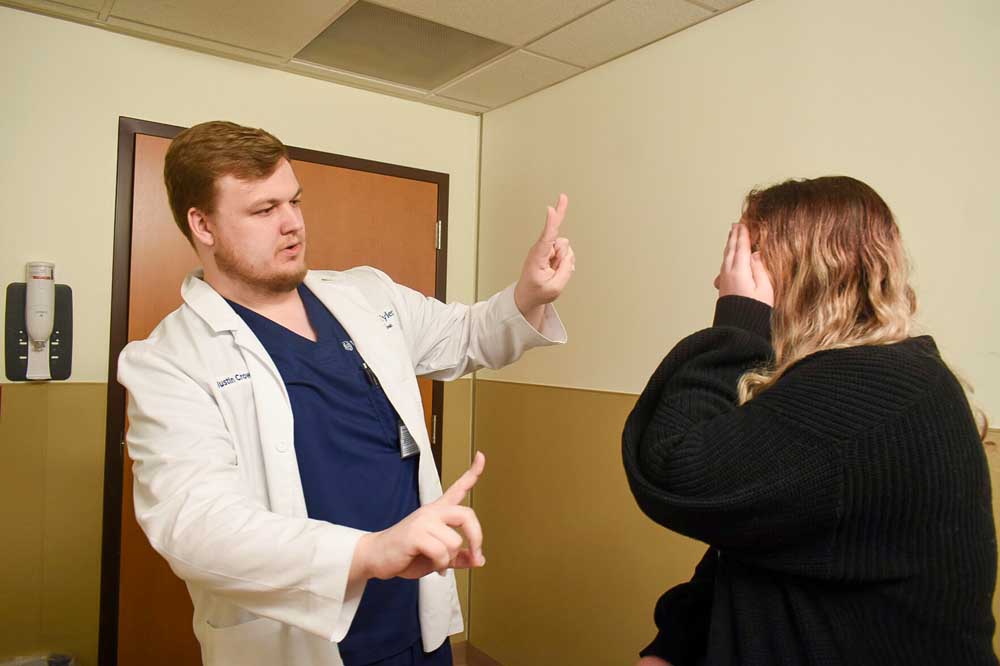UT Tyler School of Medicine set to welcome second class
Published 5:45 am Saturday, June 1, 2024

- UT Tyler School of Medicine student Justin Crowe does an eye test on simulated patient Amy Joffrion in February 2024. (Raquel Villatoro/Tyler Morning Telegraph File)
After going through nearly 3,000 completed applications for the second class of the UT Tyler School of Medicine, all 40 spots are full.
The majority of students are from East Texas, said UT Tyler School of Medicine Founding Dean Dr. Brigham Willis, with 85% of them having ties to the region.
“It’s great having the significant majority coming born and raised in East Texas, but I do think even this year, we saw a significant increase in the number of people from outside the region who were excited about our school,” Willis said.
Students are from Forney, Flint, Gilmer, Nacogdoches, Tyler, Marshall, Longview, Lindale, Jacksonville, Kaufman and Kilgore. Of the students, 80% of the incoming class are women, Willis said.
The medical school was founded to address the health needs of East Texas. The inaugural class began in 2023.
As the school welcomes more students, the curriculum will mostly be the same minus some minor tweaks and implementing student feedback. The curriculum is 100% active-learning based, Willis said. The students receive early clinical experience and do simulations.
“The students are really engaged from Day 1 and learning on-the-ground skills on how to help people, which is different than traditional medical school curricula,” Willis said. “So we’re maintaining that focus.”
The students are divided into four houses similar to “Harry Potter” so they gain connections, professional development and support. Second-year students will mentor the first-year students. In addition, there will be a tutoring program.
From the incoming class, students showed interests in various specialties in medicine including family medicine, OB/GYN, surgery, internal medicine and pediatrics.
“The majority of the students and applicants are interested in primary care, because that’s the focus we need to have to really change health outcomes in East Texas,” Willis said.
A 2022 health study published early 2023 shows the gaps in pediatric care in the region. There are zero pediatricians in 26 out of 38 counties in East Texas. The study also showed there is a high rate of child mortality in Northeast Texas when compared to both national and state averages, according to Willis. This is due to the lack of access to care and resources in the region, Willis explained.
In Northeast Texas, the mortality of pediatric patients is nearly 2.5 times higher than the national average, according to the study.
“Children are the future of our community, and it is alarming to see the significant pediatric health issues present in Northeast Texas,” said Dr. Valerie B. Smith, Smith County Local Health Authority and UT Tyler’s School of Medicine Assistant Professor of Pediatrics. “This report shows the urgent need to address the critical pediatric health care shortages in our region. We must work together to improve the health outcomes for our children and ensure they can thrive.”
According to the Pediatric Health Status Report:
Northeast Texas had higher rates of children living in poverty and food insecurity, preterm births and teen births than both the state and national averages.
The region’s children are more than twice as likely to be uninsured as their national counterparts.
Twenty-four counties don’t have a board-certified pediatrician, which means over 105,000 children in the region don’t have access to a pediatrician in their county.
In the entire 42-county region, there are no pediatric intensive care beds. Because of these shortages, families often must seek care far from home, meaning 58.4% of Northeast Texas pediatric patients have to drive more than 80 miles to receive specialty pediatric care, according to the study.
In an effort to increase the number of doctors who stay to practice in East Texas, the school has rapidly built up their residencies from three residencies four years ago. The school now offers 20 residencies and fellowships in multiple specialties, including family medicine, internal medicine, general surgery and psychiatry residencies.
“We’re building even more, next year we hope to have OB/GYN, pediatrics [and] emergency medicine,” Willis said. “Last year, we added anesthesia. There’s a whole list … But the idea is to have the training opportunity for students in every specialty of need that we have in East Texas.”
Willis is excited to meet the second class. When he met the first class, now entering their second year in medical school, he was amazed by their dedication.
“It just blows me away every day when I work with them what incredible people they are,” Willis said. “They’re so dedicated to their mission and the region. And they’ve done such amazing things. They’re incredibly empathic, humanistic people. So I’m just most excited to get to know them all. It’s one of the benefits of having a small class — I get to meet and know each student in each class.”
The White Coat Ceremony for the second class will be held June 29. The state-of-the-art UT Tyler School of Medicine building is set to be complete in 2025.
“It’s just the continued growth and building upon our success from the first year,” Willis said. “We’re literally building our new building, it will be done next year and growing GME (Graduate Medical Education), expanding research. I think it’s only going to be more exciting as we move forward.”






